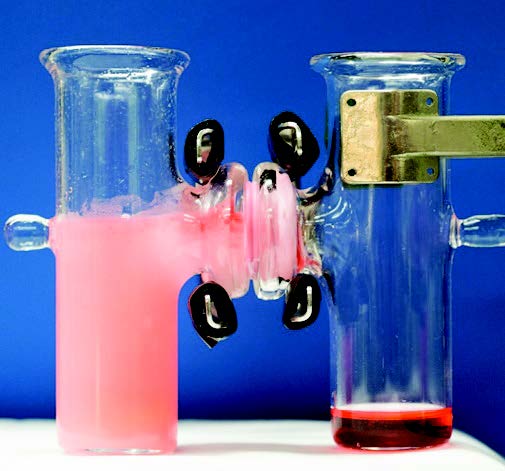Separation of oil from emulsions
Dr. Neil Canter, Contributing Editor | TLT Tech Beat February 2017
A Janus fabric coated with a single, multifunctional polymer breaks the emulsion and attracts oil droplets.
KEY CONCEPTS
•
The known techniques for separating oil from emulsions are either ineffective or can be hazardous.
•
A new approach that uses a Janus fabric coated with a multifunctional polymer has been found to effectively remove oil from emulsions.
•
The polymer is able to initially break an emulsion and then facilitate the passing of the oil droplets through the Janus fabric.
DEALING WITH OIL SPILLS AND CLEANING UP CONTAMINATED OIL remains a major challenge for the lubricant industry. A number of techniques have been proposed, but there is still room for development of a more efficient process.
In a past TLT article, derivatized metal-organic frameworks (MOFs) were prepared with perfluorinated groups and found to efficiently adsorb hydrophobic materials such as organic hydrocarbons and aromatics (
1). These compounds known as fluorous MOFs (FMOFs) rapidly adsorbed typical hydrocarbon components present in gasoline at low relative pressures. The FMOFs adsorb between 190 and 300 kilograms per cubic meters of organic molecules.
One problem faced in cleaning up oil spills is that oil may not be present in a neat state but rather emulsified with water. These emulsions are typically oil-in-water types where oil droplets are dispersed in an aqueous medium.
In lubricants, they can be found in a number of applications. For example, two of the largest types of metalworking fluids known as emulsified oils and semisynthetic fluids are prepared as oil-in-water emulsions. Water contamination in mineral oil-based lubricants also can lead to the formation of emulsions particularly due to the interaction between surface active components in the lubricant and water.
Guojun Liu, Canada research chair in materials science in the department of chemistry at Queens University in Kingston, Ontario, Canada, says, “Oil that is emulsified by the use of a surfactant in water typically forms droplets that have diameters less than 10 micrometers. The types of hydrophobic filters used to attract oil from an emulsion have pore sizes that are in the hundreds of micrometers. As a result, the pore size is too large to separate the oil droplets from the water. An additional factor is that the hydrophobic filter rejects the oil in the emulsion because the continuous phase is water.”
One option that has been used to isolate oil from the water is to use emulsion-breaking agents. Liu says, “The problem with breaking emulsions through chemical means is that the user needs to work with dangerous chemicals such as mineral acids or expensive cationic polymers.”
Another approach looked at for separating oil from an emulsion is to use a two-sided fabric. Liu says, “The fabric must contain a hydrophilic component to initially be compatible with the water and destabilize the emulsion. The oil droplets then coagulate and are attracted to the hydrophobic component on the other side of the fabric.”
These two-sided fabrics are known as Janus fabric because Janus is the name of a Roman god that had two faces. Initial attempts to prepare Janus fabrics proved to be difficult. Liu says, “Attempts to incorporate hydrophobic and hydrophilic polymers onto a fabric involved multiple steps. Each polymer had to be coated onto the fabric followed by irradiation to crosslink the polymers, extraction and grafting.”
A new approach has now been developed to simplify the development of the Janus fabric.
IN-SITU PREPARATION
Liu and his colleagues prepared a Janus fabric through the use of a single, multi-functional polymer. Diblock polymers containing acrylate monomers were prepared and coated onto cotton fabric. Crosslinking accomplished with additional acrylate groups also enabled the researchers to graft polydimethylsiloxane to the polymer.
Liu says, “The key to the effectiveness of this polymer is that a specific group rises to the top of the coating depending upon the environment.” In effect, the fabric changes its properties
in situ. The movement of polymer groups from the top to the bottom of the coating is known as surface reconstruction.
In the presence of air, polydimethylsiloxane chains are found at the top because this functionality reduces the surface tension in air. When one side of a fabric contacts an oil-in-water emulsion, the hydrophilic acrylate chains rise to the top of the coating because they are hydrophilic. These chains then break emulsions stabilized with anionic surfactants through a charge-screening effect to produce coagulated oil droplets.
The oil droplets are then attracted to the polydimethylsiloxane chains on the other side of the fabric that has not contacted the emulsion. Liu says, “The oil droplets migrate to the fabric side bearing polydimethylsiloxane surface chains through a hydrophilic–hydrophobic gradient capillary force across the fabric.”
The Janus fabric was evaluated by placing water droplets onto the fabric coated with the diblock polymers. Initially the water contact angles are above 150 degrees due to the presence of polydimethylsiloxane groups on top of the coating. But, over a time frame that ranges from seven to 23 minutes depending upon the polymer composition, the surface becomes hydrophilic and the contact angle drops to zero.
Figure 2 shows what occurs when a red emulsion in the container on the left passes through the Janus fabric leading to the isolation of a darker red-colored oil in the container on the right.
 Figure 2. A dark red-colored oil is isolated on the right after the reddish emulsion on the left passes through a Janus fabric placed between the two glass containers. (Figure courtesy of Queens University.)
Figure 2. A dark red-colored oil is isolated on the right after the reddish emulsion on the left passes through a Janus fabric placed between the two glass containers. (Figure courtesy of Queens University.)
The researchers found that the Janus fabric was very durable after running seven consecutive trials. Successful testing was done with emulsions based on hexadecane, toluene and chlorobenzene. The surfactant used in stabilizing emulsions was sodium dodecyl sulfate.
Future work will focus on improving the effectiveness of the polymer used and evaluate the effectiveness of the polymer on other fabrics besides cotton. Additional information can be found in a recent article (
2) or by contacting Liu at
gliu@chem.queensu.ca.
REFERENCES
1.
Canter, N. (2012), “A new type of ultra-stable oil adsorbent,” TLT,
68 (3), pp. 14-15.
2.
Wang, Z., Liu, G. and Huang, S. (2016), “In situ Janus fabrics for the rapid and efficient separation of oil from oil-in-water emulsions,”
Angewandte Chemie International Edition,
55 (47), pp. 14610-14613.
 Neil Canter heads his own consulting company, Chemical Solutions, in Willow Grove, Pa. Ideas for Tech Beat items can be sent to him at neilcanter@comcast.net
Neil Canter heads his own consulting company, Chemical Solutions, in Willow Grove, Pa. Ideas for Tech Beat items can be sent to him at neilcanter@comcast.net.